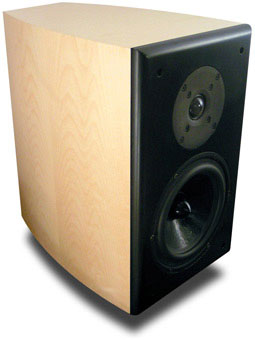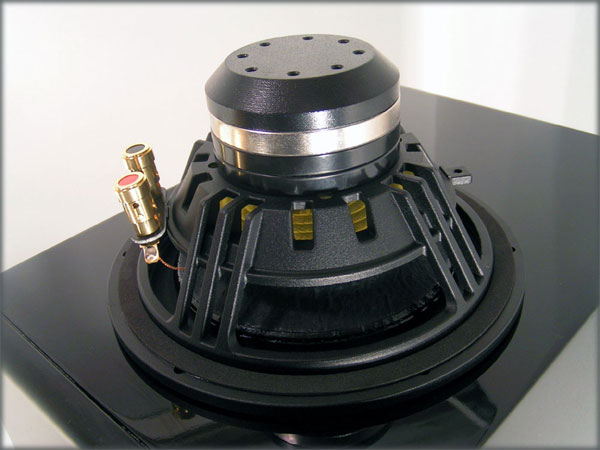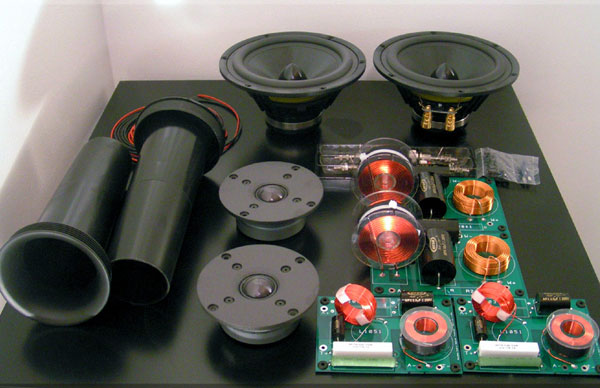![[SoundStage!]](../sslogo3.gif) D-I-Why & How D-I-Why & HowBack-Issue Article |
|||||||
April 2008 Exodus Audio Kepler Loudspeakers
The Kepler has a history going all the way back to 1571. No, it hasn’t been in development for four and a half centuries. This loudspeaker is named for German mathematician and pioneering astronomer Johannes Kepler (1571-1630). While his may not be a household name, Kepler bequeathed to humanity his laws of planetary motion. Exodus Audio’s history isn’t quite so storied, but it has been a respected member of the DIY audio community for several years. Through its www.diycable.com website, Exodus sells a family of amplifiers based on Hypex UcD class-D technology as well as subwoofer kits and a variety of DIY cables, connectors and related gear. The Kepler, a two-way ported minimonitor designed by Exodus owner Kevin Haskins, is the first of a planned family of loudspeakers. Haskins says that he wasn’t interested in producing just another kit speaker at a low price. Instead, he was determined to produce an industry-leading two-way speaker without regard to budget constraints. When he surveyed the drivers available from OEM suppliers, Haskins realized there was no midrange/woofer on the market that met his requirement for ultra-low distortion. The only solution, then, was for him to design a driver -- the EX-6.5 mid-woofer -- from scratch. As Haskins explained, "When you’re designing your own driver, the sky is the limit in terms of getting exactly what you want. We quite frankly decided we could design something better than we could source from the off-the-shelf vendors." Quality control was another issue. "If you buy off the shelf, you have no guarantee from one batch to the next that you’re getting the same driver parameters you designed for, so the end result can suffer. By designing the EX-6.5 ourselves, we know what we’re getting because the drivers are built to our tight specs every time."
The EX-6.5 uses a rigid cast basket with built-in gasket to seal the driver to the enclosure baffle. The basket provides a very solid foundation for the driver’s 6 1/2" treated-paper cone and aluminum phase plug. Control is achieved through the use of a progressive spider and a rubber roll surround. But what’s truly special about this driver is its use of a patented motor technology called XBL2. Although the details are proprietary, what we do know is that the XBL2 motor offers 25-50% more excursion than a standard motor while maintaining very low distortion. What this means is that the bass output of the EX-6.5 is on par with high-end 8" drivers, which have 50% more cone area. To help ensure that the motor and 1 1/2" copper voice coil stay cool and unstressed, Haskins designed in extensive venting. The long-term goal at Exodus Audio is to design a proprietary tweeter, but for now Haskins admits that the top-of-the-line Peerless HDS tweeter is "excellent," explaining, "I didn't want to go with a proprietary unit just for the sake of doing so and sacrifice sound quality." The HDS is a "low-mass soft-dome tweeter with high internal damping and a highly optimized low-compression magnet." To you and me, it’s one sweet tweeter. Controlling these drivers are high-quality fourth-order crossovers, with the actual passing of the frequency baton between drivers occurring at a relatively low 1500Hz. Most speakers in the Kepler’s price range (and far beyond) employ inexpensive electrolytic capacitors in their crossovers, but Exodus Audio uses only audio-grade film-and-foil caps that are many times more expensive. The resistors and inductors are also audio-grade parts. Clearly, Haskins was serious when he said that cost is not an object with the parts he chose. For ease of assembly, the crossovers are delivered pre-assembled (as pictured), so the builder simply has to mount them inside the speaker enclosure and attach the included hook-up wire to the drivers and binding posts. Although he’s very pleased with the crossovers as they are, Haskins is offering upgrades and some minor tweaking if a builder wishes to make changes from stock. Because of the wide variety of choices available, contact Exodus Audio directly for more information. I used stock crossovers with the biwiring option.
Up to now the single biggest excuse I’ve had for not building speakers is that I can’t cut wood to save my life. I can solder perfect joints all day long, but when it comes to woodworking I am a disaster waiting to happen. And even if I could assemble a solid enclosure, finishing it to any kind of acceptable standard would be as big a challenge. But fear not, wood-phobes, Mr. Haskins has taken care of the cabinet too. The Kepler was designed from the outset for the 0.5-cubic-foot pre-assembled cabinets sold by Parts Express, which come beautifully finished in high-gloss piano black or in real maple or cherry veneer. The cabinets are solid, sturdy, non-resonant and are really quite stunning. The front baffle, which comes only in flat-black, is removable, so if you plan to use your own router to cut the driver holes the task will be much simpler. Attaching the baffle to the cabinet is easy: Four screws fit four pre-drilled holes. Don’t have a router? Think I’m talking about the thing that beams your Internet connection to your laptop? Never fear -- Kevin is here! Although the final details weren’t worked out in time for me to discuss them in this article, Haskins will soon be offering optional CNC-cut baffles for about $20 each, which will arrive ready to receive the woofer and tweeter. By taking up the pre-cut baffle option, the only cut the Kepler builder will have to make is a 3 3/4" circular hole in the back of the cabinet for the port. Haskins reckons that the average builder will be able to assemble the pre-cut baffle kits in about two hours. When they’re assembled and ready to rock'n'roll, the Keplers are said to have a +/-2dB frequency response of 38Hz-20kHz and an easy-to-drive nominal 8-ohm impedance. Sensitivity is somewhat low at about 85dB/W/m; however, I had no trouble driving these speakers hard with my 17Wpc Audio Note Kit 2 tube amplifier. Curiously, though, my Blue Circle CS integrated amp did not like the Keplers at all, and that combination produced underwhelming output levels and flat sound. Wondering if the Keplers had an issue with transistor amps, I then tried them with the Simaudio i-1, the DIY Paradise Charlize 2 and a Marantz SR8400 receiver, none of which had any trouble driving the Keplers and bringing out their best. Chalk up the Blue Circle issue to synergy, which is sometimes there and sometimes not. The Keplers are not overly fussy about their place in the listening room. I found that any closer than three feet to the front wall and the bass tended to bloat, but beyond that limitation the speakers were quite easy to position. In my room I found the best spot to be about four feet from the front wall and two feet from the side walls. All listening was done with the Keplers atop 26" sand-filled metal stands, which put the tweeter 36" off the floor. Per Haskins’ suggestion, I toed-out the Keplers so that my listening position was about ten degrees inside the tweeter axis. It took no time at all for me to realize that the Keplers have mojo. Even as I write this in a room adjacent to where the Keplers are playing, I find my head bobbing along to the music. The Keplers have a rightness about them that is intoxicating. They are musical, fun-to-listen-to speakers that have the ability to make you completely lose track of time or not give a damn that it’s late and you’ve got to get up for work. Haskins’ integration of woofer and tweeter is exceptional, and the crossover point does nothing to call attention to itself. That’s impressive, as the crossover point occurs right in the middle of the frequency band of the human voice, and you might expect to notice a problem with female vocals, for example. However, while working my way through Holly Cole’s Shade [Alert 528103], I never noticed any discontinuities. Cole’s wounded tone on "We Kiss in a Shadow" comes though with all its pain and confusion intact. The Keplers are speakers with plenty of punch, and they excel at revealing detail. Kenny Washington’s superb rapid-fire brushwork on the Bill Charlap Trio’s version of "My Shining Hour," from Live at the Village Vanguard [Blue Note 97044], offers plenty of dynamic variation -- from quiet, subtle slides across the snare head, to explosive tom-tom hits and bass-drum kicks. The Keplers handled the transitions with aplomb, and the detail was so fine that I swore I could pick out each and every bristle on Washington’s brushes.
Bass performance was almost what I’d expect from an XBL2-equipped speaker. I say "almost" because after he’d shipped the Keplers for this review, Haskins discovered that the Parts Express cabinets actually have a little less than the advertised 0.5 cubic feet of internal volume, which throws off the bass performance to a small degree. The problem has since been rectified in production kits, but I wasn’t able to get my hands on a "fixed" pair of Keplers. That said, the speakers in my listening room did not sound like they were missing any bass. In fact, they sounded more like floorstanding speakers than minimonitors. According to Haskins’ own measurements of the modified design, in-room response should go down to 40-42Hz. Whatever handicap the test pair may have faced, I can report that I actually laughed out loud in surprise when the Keplers reproduced all but the lowest organ notes of the "Mars" section from the the Montreal Symphony Orchestra's recording of Holst's The Planets recording [Decca 417553-2], and they did so with a lot more authority than the laws of physics would seem to permit. So I've established that the Kepler is a fine kit speaker, but how does it do against its mass-produced competition? Not surprisingly, it does very well indeed. As noted elsewhere on SoundStage!, the B&W CM1 ($900 per pair) combines a magnificent Nautilus tweeter with B&W's trademark Kevlar-cone midbass driver. With the CM1's much smaller 5 1/4" woofer and diminutive cabinet, you might think that it would be at a distinct disadvantage in the bass department. Don't bet on it! Sure, the CM1 can't reach as low as the Kepler -- and it doesn't have the same authority deep down -- but the B&W speaker did surprisingly well. In my room, though, the CM1 proved quite sensitive to boundaries, and no amount of trial and error completely eliminated the lower-bass bloat -- even after installing the included port plug. On the other hand, the CM1's beautiful tube-loaded tweeter was well mannered and a delight to look at and listen to. It projected a large, deep soundstage with rock-solid images. It was crisp and clear, and it conveyed terrific micro detail. But do the CM1s have the Kepler’s mojo? The B&Ws went on full-time duty for the two weeks that the Keplers were off at the NRC, so I had ample opportunity to run the gamut of my test music through them. While I’d give the treble gold medal to the CM1's stunning tweeter (but not by a large margin), for bass performance, overall integration, and the all-important enjoyment factor, I found the Keplers to be the much more satisfying speaker. With the Keplers I sat for hours on end, happily losing track of time. I just can’t say the same for the CM1s. Over in publisher Doug's expansive room, the Keplers were in very fine form connected to $9000 worth of Simaudio gear. Although we didn't have time to evaluate the Keplers critically against other speakers there, we did do quick comparisons that revealed the Keplers were nearly the equal of the $1500 Paradigm Signature S1 v.2 in overall tonal signature (minus the low bass). Mated to the Simaudio i-l integrated amplifier, I thought the Keplers outperformed the much more expensive KEF Reference 201/2s, which, admittedly, might have been tough for the 50Wpc amp to drive. Doug's terse assessment: "These Keplers are very good speakers!" Right at the end of the review period I added the Simaudio Moon i5.3 integrated amplifier to my reference system. With 72 hours on the amp, it’s beginning to open up and it really, really digs the Keplers. I’m betting that the i5.3, which costs four times more than the speakers, is more than good enough to bring out the speakers’ very best. Let me tell you, its very best is very, very good. With this combination of amp and speakers I’ve embarked on a marathon campaign of rediscovering my favorite recordings and I’m loving it. As I suspected after listening at Doug’s, these speakers would not be out of place in pricey, high-performance systems. There's an old expression that if it looks like a duck and quacks like a duck, it's a duck. Well. the Exodus Audio Kepler looks like a professionally manufactured product and it sounds as good as or better than its peers from the speaker world's biggest names. And yet this is no duck. The Kepler is an easily assembled kit made up of excellent-quality parts. It is a speaker that overachieves on every measure, and it not only sets the bar high for other kit speakers but for any other loudspeaker below $1500 a pair. The Exodus Audio Kepler is a remarkable achievement worthy of Johannes Kepler's name and the SoundStage! Reviewers' Choice tag. ...Colin Smith
|
|||||||
|
|||||||
![[SoundStage!]](../sslogo3.gif) All Contents All ContentsCopyright © 2008 SoundStage! All Rights Reserved |



